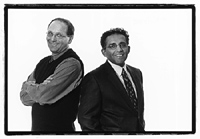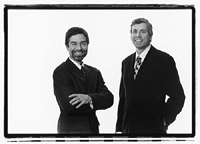| |
 |
| |
 |
| |
Merging
their insights: Kellogg Professors Thomas
Lys and Ranjay
Gulati (top, left to right) and Ed
Zajac and David
Dranove (bottom) help students and executives
understand the dynamicsof mergers and alliances. |
| |
© Nathan Mandell |
| |
|
Mergermania
Why
bigger is not always better where corporate mergers are concerned
By
Matt Golosinski
Would
you invest your money in a project that offers an expected
return of minus 3 percent and has odds of losing capital 55
percent of the time?
Kellogg
School Professor Thomas Lys believes the question is one business
leaders should contemplate before getting involved with corporate
mergers, especially since research indicates that more than
60 percent of the record 302 major mergers transacted between
July 1995 and September 2001 actually lost money for shareholders.
“History
is full of these kinds of examples,” says Lys, the Gary
A. Rosenberg Distinguished Professor of Real Estate, and one
of the Kellogg mergers and acquisitions experts who teaches
a course on M&A financial planning. “One of the
biggest deals in the 1980s was the AT&T and NCR acquisition,
which totaled about $10 billion. AT&T lost $6 billion
on this.”
Other
blockbusters, such as America Online’s $166 billion
stock bid for Time Warner that resulted in their January 2000
merger, promised to launch juggernauts facilitating investor
windfalls and enhanced customer services. The reality has
proven more problematic, with a raft of problems dogging the
firm. Today, the company is listing, having shaken up senior
leadership after losing more than 75 percent of its post-merger
value. Some observers believe that marketplace shifts, particularly
the development of broadband in the three years that AOL Time
Warner tried to find its new legs, have left the media firm’s
plans DOA.
Kellogg
School scholars note that the difficulty in making mergers
work can manifest itself in any number of ways, but the challenges
come down to these fundamentals: business strategy and implementation.
Supersize
me!
If most firms can’t pull off a merger that creates valuable
synergies, why did five times more merger activity occur in
six of the last eight years than in the entire history of
M&A? According to a BusinessWeek study, deals totaling
about $4 trillion took place between 1998 and 2000 alone.
Part
of the reason has to do with those odds. Forty percent of
the time, mergers do make a positive financial impact for
the firm, and excessive confidence may drive CEOs to believe
they can create one of the winners.
“A
lot of ego goes into merger attempts,” says Walter Scott,
professor of management and strategy and a merger expert who
has himself been on the front lines of M&A as former president
and CEO of Minneapolis-based IDS Financial Services (now American
Express Financial Advisors). “You get seduced by your
own press clippings so you think you won’t make the
same mistakes others have.”
Other
factors contributing to merger mania included inflated stock
value during the Internet boom that resulted in dot-com executives
looking to unload the paper without alarming shareholders.
One way to achieve this goal, while keeping Wall Street happy,
was orchestrating spectacular deals using new economy stocks
to trade for real, old economy assets. In these cases, due
diligence was sometimes sacrificed for perceived immediate
benefits.
Some Kellogg
School faculty, including Management and Strategy Professor
David Dranove, believe this is what CEOs such as AOL’s
Steve Case was doing when he teamed up with Time Warner’s
Gerald Levin. Neither man hurt his reputation or company,
in the short term, when they announced the merger and appeared
on the cover of The Wall Street Journal, arms trium-
phantly raised.
“It
was as if they’d just won the Super Bowl,” says
Dranove, the Walter J. McNerney Distinguished Professor of
Health Industry Management. “But to win the Super Bowl
you actually have to accomplish something. You can’t
just sign a free agent at the beginning of the year and declare
victory.”
One of
the abiding faiths of commercial culture is that “bigger
is better.” Today, beverages and burgers are “supersized,”
but that’s merely the fast-food example of a model that
appears everywhere, including the automotive industry. During
the 1990s, many CEOs also discovered an appetite for big deals.
Too often,
though, their decisions demonstrated leadership big on vision,
but small on strategy.
“Big
is not necessarily better. You tend to give up speed, flexibility,
entrepreneurial character when you get bigger,” says
Scott.
Scott
adds that firms usually suffer when poor logic underpins their
merger attempts. He recalls his tenure as executive vice president
at Pillsbury Co., coming on board after the company had “listened
to the siren song” that recommended becoming a “concept
stock” — a boutique stock that typically sells
at a higher price. In Pillsbury’s case, the concept
translated into “finer living.”
As a
result, Pillsbury became involved with businesses it had little
expertise in, including fresh flowers and wine. There was
no logic in this strategy, says Scott, who contends that the
company was charmed by prevailing Wall Street wisdom.
Similarly,
he notes that “nearly every food company entered the
restaurant business” in the 1980s, based on the flawed
logic that because it involved food, managing it would entail
the same skills. Not so, says Scott, pointing to the industries’
different dynamics.
His rules
of thumb? Never get involved with a company that you don’t
have at least a basic understanding about and be clear on
your motivations for merging.
“I
want to know why I’m doing the deal; what the inherent
business logic is that will make the combined enterprise better
than it was before the merger,” Scott explains.
Culture
clash
Even if companies clear the strategic hurdle by initiating
a merger that promises real synergies, they still must manage
the integration challenges and inevitable culture clashes,
says Ed Zajac, the James F. Beré Distinguished Professor
of Management and Organizations.
Zajac,
along with Professor Tony Paoni, traveled to Washington, D.C.,
earlier this year to assist with the implementation of a merger
at top levels of U.S. government; namely, the newly formed
Department of Homeland Security.
“There
can be enormous cultural impediments when creating mergers,
and with government agencies there are special challenges,”
says Zajac, who shows students in both the full-time MBA program
and Executive Education Program how to extract real value
from mergers and alliances as in such courses Creating
and Managing Strategic Alliances. For example, the course
provides an analytical framework that identifies the environmental,
strategic, structural, and behavioral factors predicting the
relative desirability of mergers versus alliances versus outsourcing
options.
In the
case of merging government entities, Zajac notes that internal
cultural issues idiosyncratic to government organizations,
such as politically motivated hiring and promotional systems,
create additional complexities.
“Even
details as seemingly trivial as uniform insignias can present
challenges. Whose badge will survive the merger? These things
matter to the people wearing the uniforms,” Zajac says.
Lys agrees,
citing other cultural considerations such as whose accounting
system survives and what managerial protocols the post-merger
company will follow. Personnel issues can be another significant
challenge.
“Mergers
are frequently an adverse selection for excellence,”
Lys states. “You can end up with an exodus of the most
brilliant people, which leads to keeping — out of necessity
— the people you should get rid of.”
For Ranjay
Gulati, the Michael Ludwig Nemmers Distinguished Professor
of Strategy and Organizations, a key to successful merger
strategy is formulating a strong integration plan.
Gulati
says that executives often make the critical error of underestimating
the costs and challenges of integration, while overestimating
the value they perceive in merging. Gulati is currently teaching
a course called Strategy of Implementation that addresses
ways to leverage good ideas in real-world contexts.
“Post-merger
integration is a nightmare,” he says. “If you’re
not adept at it, you are in a total mess.”
The
synergy myth
Zajac says that among the misconceptions held about mergers
is their justification. “Many corporate leaders couch
the merger in terms of efficiency gains, because that is the
socially acceptable answer. We hope that it’s also true,”
he says.
Gulati
contends that merger architects often believe they are creating
these efficiencies via synergies. In his research and teaching,
he refers to “the synergy myth” and uses the equation
1+1=3 to demonstrate the flawed logic behind this belief.
While
he says that mergers can create value through economies of
scale (such as eliminating operational redundancies to reduce
costs in common activities), or through economies of scope
(in operational, financial and anticompetitive domains), Gulati
notes that synergies are more difficult to create than is
commonly believed.
His research
cites the “failed synergies” of companies such
as Vivendi Universal, The Walt Disney Co. and Bertelsmann
Media Worldwide, each of which gambled poorly on Internet
communications to increase sales and productivity. Each company’s
stocks suffered big losses in the aftermath of their miscues.
Scott
is equally dubious about using merger buzzwords, and says
that very few guaranteed synergies exist. One true synergy
results from deals that increase availability of additional
capital to support expansion and improve operations.
In his
research and consulting, Dranove has found that when some
hospitals tried to create synergies either by merging, or
else through strategies such as buying up physician practices
or selling insurance, the results were usually a prescription
for disaster.
“The
deals that hospitals struck with insurance companies were
amazing,” says Dranove. The hospitals agreed to take
on all the risk themselves so long as the insurance companies
did the marketing. Hardly a plan that encouraged due diligence
on the latter’s part, since their financial incentive
came from signing up more patients, regardless of existing
health problems.
The theory,
says Dranove, was the same as for any for any merger. The
organizations would lower costs and reap the profits by creating
new methods of delivering care that would produce higher quality
at a lower cost. In the end, these organizations spent time
and money on mergers that failed to create any new product,
and certainly didn’t discover more efficient ways of
delivering existing products and services.
“We
learned that two fundamental rules of business always apply:
Don’t do things you don’t know how to do; and
merger does not equal synergy,” says Dranove.
Kellogg
School faculty indicate that, for a decade now, the school’s
core strategy course has advised managers to adopt extreme
caution when growing their firms through acquisition. They
always counsel executives to ask themselves why they could
not achieve their goals as an independent firm, rather than
taking on merger or alliance risks.
“The
key is figuring out what you must own versus what you can
farm out,” says Lys. “Generally there are two
types of assets you must own — anything that determines
the barrier to entry, and whatever defines the product. Typically
managers assume too broadly what they must own.”
But sometimes,
admits Dranove, economists such as himself put the brakes
on deals that really are worth the gamble. He says academics
have to do a better job of identifying the really excellent
mergers so that when they do preach caution others will listen.
“Economists
spend a lot of time saying, ‘I don’t think that
will work,’ Dranove says. “We’d be terrible
CEOs because when the time comes to make a killing in the
market, we would still be skeptical.”
|



